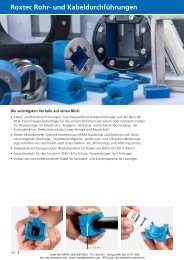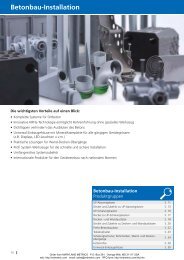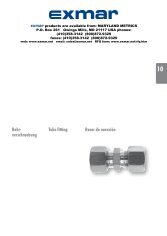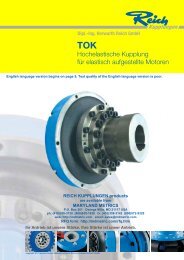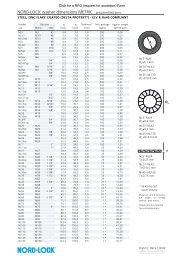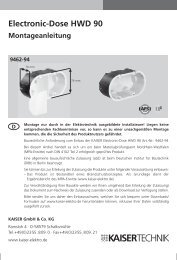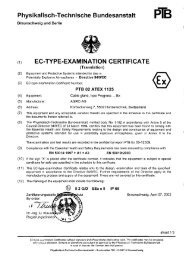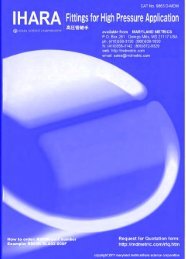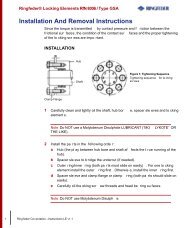Seal-Lok™ O-Ring Face Seal Tube Fittings
Seal-Lok™ O-Ring Face Seal Tube Fittings
Seal-Lok™ O-Ring Face Seal Tube Fittings
Create successful ePaper yourself
Turn your PDF publications into a flip-book with our unique Google optimized e-Paper software.
4300 Catalog<br />
<strong>Seal</strong>-Lok Introduction<br />
The <strong>Seal</strong>-Lok fitting was developed by the <strong>Tube</strong> <strong>Fittings</strong> Division<br />
in the early 1980s. This product has proven to be very effective<br />
in eliminating leakage at the higher pressures found in today’s<br />
hydraulic systems. It meets or exceeds the strict requirements<br />
of SAE J1453 and ISO 8434-3. The <strong>Seal</strong>-Lok fitting is an O-ring<br />
face seal type fitting that consists of a nut, a body, an O-ring and<br />
a sleeve (Fig. A1). As shown in Fig. A3, the tube is flanged to<br />
90° (or the tube may be brazed instead to a braze-type sleeve).<br />
When the fitting is assembled, it compresses an O-ring in the<br />
precision machined groove of the fitting body to form a leak<br />
tight seal.<br />
<strong>Seal</strong>-Lok fittings are suitable for a wide range of tube wall thicknesses<br />
and are readily adaptable to pipe, inch or metric tubing<br />
and hose. (Please refer to Tables A2 and A3 for min./max. tube<br />
wall thickness for inch and metric tubing, respectively). <strong>Seal</strong>-<br />
Lok’s leak-free design and rugged construction make it suitable<br />
for a wide range of applications where higher pressures, vibration<br />
and impulse are prevalent. It is popular in markets such as<br />
construction, agriculture, machine tool, utility, paper making,<br />
automotive, etc.<br />
Design and Construction<br />
The <strong>Seal</strong>-Lok fitting consists of four main components: a body,<br />
a sleeve, an O-ring and a nut. The more popular materials from<br />
which <strong>Seal</strong>-Lok is manufactured are shown in Table A1.<br />
The <strong>Seal</strong>-Lok Fitting Body. There are over 60 different body<br />
configurations to choose from for specific applications. The body<br />
face is manufactured with Parker’s CORG (captive O-ring groove),<br />
which keeps the high durometer O-ring captive during installation<br />
(see Fig. A2). In addition, the <strong>Seal</strong>-Lok fitting body shapes<br />
are forged for added strength and longer service life, eliminating<br />
the potential leak paths associated with multi-component brazed<br />
fittings. Straight products are made from cold drawn barstock.<br />
The cold drawing process ensures consistent dimensional tolerances,<br />
improved strength and better surface finish.<br />
The <strong>Seal</strong>-Lok Fitting Nut. <strong>Seal</strong>-Lok tube nuts are either cold<br />
formed or machined from cold drawn bar stock, depending<br />
on the size. The cold forming process increases the material<br />
strength and its fatigue properties, imparting high strength and<br />
longer service life to the nuts.<br />
The <strong>Seal</strong>-Lok Flange Sleeve. The preferred method of making<br />
a <strong>Seal</strong>-Lok connection is by using the Parker Parflange machine<br />
(see section S) to create the 90° flange on the tube end. A flange<br />
sleeve is used to support the flange and the tube. It also provides<br />
the contact shoulder for the nut, a back-up for the 90° tube flange<br />
and support at the tube O.D (see Fig. A3). The<br />
Parflange process provides the following advantages:<br />
• Several times faster than brazing.<br />
• Does not require any special pre- or post-flange cleaning.<br />
• Cleaner and safer than brazing.<br />
• Accommodates the use of plated or unplated sleeve and<br />
tube.<br />
• Eliminates a potential leak path associated with braze<br />
joints.<br />
Dimensions and pressures for reference only, subject to change.<br />
A5<br />
<strong>Seal</strong>-Lok O-<strong>Ring</strong> <strong>Face</strong> <strong>Seal</strong> <strong>Tube</strong> <strong>Fittings</strong><br />
Fig. A1 — <strong>Seal</strong>-Lok Fitting Body, O-ring, Sleeve and Nut<br />
Fig. A2 — Captive O-ring Groove (CORG) Cutaway<br />
<strong>Seal</strong>-Lok<br />
<strong>Fittings</strong><br />
Steel Stainless Steel<br />
ASTM Type ASTM Type<br />
Forged Bodies A576 1214/1215 A182 316<br />
Bar Stock Bodies A108 12L14 A479 316<br />
Cold Formed Nuts A576 C1010 -- --<br />
Machined Nuts* A108 12L14<br />
11L37 A479 316<br />
Braze Sleeves &<br />
Braze Connectors A108 12L14 A276 316L<br />
Flange Sleeves A108 12L14 A479 316<br />
Table A1 — Standard Material Specifications for <strong>Seal</strong>-Lok<br />
<strong>Fittings</strong>*All stainless steel nuts are coated to prevent galling at assembly.<br />
Note: Other materials can be produced upon request.<br />
Finish: Zinc with yellow chromate (being changed to zinc chromium<br />
6 free) is used on all standard steel products. Stainless steel fittings<br />
are passivated.<br />
Parker Hannifin Corporation<br />
<strong>Tube</strong> <strong>Fittings</strong> Division<br />
Columbus, Ohio<br />
http://www.parker.com/tfd



